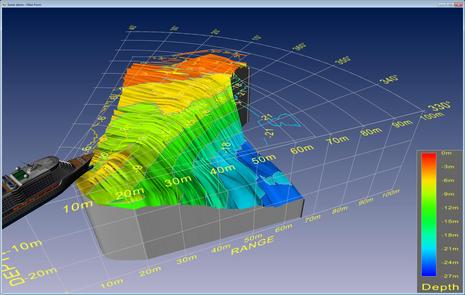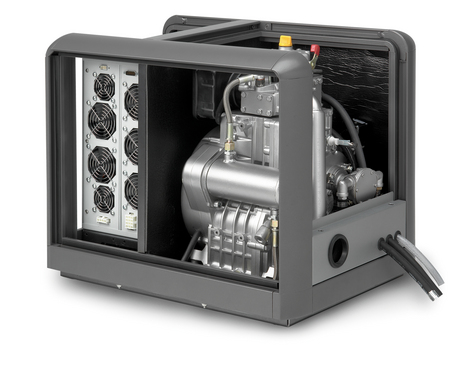Kees at Mets, almost like walking the show
... written for Panbo by Ben Ellison and posted on Nov 19, 2009

Wow, Kees Verrujit, our N2K Panbot in an attic, has out done his own reporting on last year's METS, and he even shot some videos for us. A collective tip of the beanies to Kees, please:
In
general the feeling was quietly positive. Everyone still around will probably be able to weather the remainder of the economic storm. Attendance today was lower than the earlier two editions I visited, but then this was my first time visiting on the last day so I can't say for
sure how busy it was. Sorry to say, there was no big big news. Still there were a number of exciting new developments. I've kept those to the end of this long mail!
There were two things that
stood out from the crowd for me. First of all there is a definite trend
towards using computer displays for 'dedicated' engine displays. With
that I mean that the suppliers of engine dials are all scrambling to
produce flexible displays that can show multiple pages of J1939 or
other engine data. The other one is lighting. There were NO lights to
be found other than LED. Last year you could see maybe 50% LED with
some leading companies going all the way, but now everyone has fully
switched over.
Weather
As I
suspected there was no news (or I missed it) on marine weather. As
there are no digital radio satellites over here (that's done over
normal airwaves) there is no XM or Sirius weather in Europe, so nobody
that I saw focused on satellite weather. There were a number of
satellite TV dish suppliers though, including some new Asian companies.
It looks as if Intellian and KVH are going to have competition on their
hands.
MFD developments
I
did make a point of looking at all three new MFDs (at least for me):
the Raymarine E series Widescreen (with touch), the Simrad NSE 12 and
the Garmin GPSMAP 6000/7000 series (where the 7000 has touch as well).
My subjective impressions:
-
Raymarine E series was either running Beta or else it's not done (
video here).
The touch screen worked but dragging charts was very clumsy and
non-intuitive as the display lagged 1 to 2 seconds behind my input.
That immediately destroys the illusion of actually dragging what you
see on the screen. Otherwise a decent plotter, but not a great step
from the C series Widescreen. {Editor: E Widescreen software is definitely Beta, but was looking good to me on Penobscot Bay today; more on that tomorrow.}
-
Simrad NSE. Now that was more like it. Zooming and scrolling was impressively fast, and intuitive (
video here).
The way that detail builds up once you are at a new zoomlevel is one of
the best I have seen. It felt stable and solid in operation, even
though it did not have a touchscreen.
-
Garmin GPSMAP 6000/7000. Claimed to be superfast this shows up really well in this
GPSMAP 7015 video.
I was really impressed with how the automatic guided routing was able
to determine that the boat should use the "small boat" lock in
IJmuiden. Now this was explicitly running Beta software cut especially
for the show. This was noticable as I was able to lock up the 6000
quite easily (
video here).
Also, booting it took 52 seconds. I'm sure that Garmin will fix this
before they go into production. When they do this they will have a
winner on their hands. Using it immediately made the older ones look
clumsy. Navnet 3D is slow compared to these babies. Pity they're so
expensive.
Shown
using a number of Lowrance displays. The current marketing no longer
pushes lower radiation as the major point, it's down to the fourth item
on the list. The claims made now are more realistic and state:
- Crystal clear image
- InstantOn (TM)
- Low power consumption
- Extremely low emissions
- Quick installation
- Automatic clarity
NMEA sensors
Maretron did not have anything new that they cared to
talk about. I have it from other sources that they are working on some
non-display stuff, but that's apparently all still hush hush.
Airmar did have lots of interesting news for the Panbots. First of
all, the DST 900 is in active development and they plan to release it
'when it is done'. This hopefully means 2010, but they might encounter
a snag. That will follow a redesigned CS 4500 where they will split the
actual depth sensor from the electronics, which will be in a separate
black box. That black box will produce both NMEA 2000 and 0183, just
like the PB 200. There's also a ST 800 coming, which will lose the
Depth but still be a "smart sensor" that produces NMEA 2000. The PB 200
will gain even more sensors such as relative humidity. After developing
the PB 100 they left that out of the PB 200 as the actual sensor would
corrode in the marine environment, but they plan to tackle that using
field replaceable humidity sensors.
NKE showed an
ultrasonic speed sensor as well, this works as a replacement for standard paddlewheel sensors or as a NMEA 0183 sender.
I congratulated
Actisense on achieving NMEA 2000
certification for their NGT-1 and NGW-1 NMEA 2000 interfaces, but they
were able to enlighten me about what was actually certified. Although
Actisense can now claim that the NGT-1 is NMEA 2000 certified, other
vendors producing software that uses their NGT-1 cannot claim that
their software is NMEA-2000 certified -- yet. For that they are
actively working with the NMEA and there will be a process where
vendors have their software tested by Actisense for a very low fee
after which the vendor can use the NMEA 2000 label.
NMEA-2000 use by other type of vendors like
engines, smart electrical buses etc. is improving but not yet really
fully on with all manufacturers. Empirbus was showing a new generation
of digital power switching system
called NXT that is NMEA 2000 based (as well as Ethernet).
This
interesting new diesel generator combines three products in one: a
mains inverter, battery charger and diesel generator {photo below}. The diesel
generator can vary the revs (1200 to 3600) and its output. The output
is 400V which feeds to the inverter. The inverter can supply 3.5 kW
with an additional boost of 4 kW from the battery. Since the 230 or 110
V power is generated digitally the power is much cleaner than that
supplied by normal inverters. Since the inverter can borrow power from
the battery it can supply much higher startup loads and therefore the
size of the generator can be chosen to be just a little larger than the
normal working load instead of the peak load. Boat builders save on
installation as there is only one box to fit. Boat owners get lower
noise levels as the generator can run at different speeds, so it will
run at low speeds if possible. It will automatically shutdown if the
load is too low and use the batteries instead.
The GPX5 is fully programmable, so you can for
instance program it such that it either runs until the batteries are
100% and two hours after that, or until the batteries at 80% and start
when the batteries are at 20%, except between midnight and 08:00 AM.
We asked the obvious questions:
- Why all in one? What happens if the generator fails?
- Don't the electronics suffer from the heat produced by the engine?
According to Mastervolt, the all-in-one approach is more efficient as
the generator can produce voltages and frequencies that are unsuited to
be fed directly to devices. It's the inverter that converts that into
clean mains power. This improves system efficiency and also allows the
generator to always run "loaded" so that it does not run at unnecessary
speeds. If the generator fails the battery charger and inverter still
function normally. The system has been engineered such that the
electronics are shielded from the heat of the engine.
Forward looking sonar
Echopilot showed a brand new exciting product called "Echopilot 3D" (
video here) {and screen shot at top}.
This uses their usual black box approach where you show the output over
video input to a MFD or computer display. Unlike their existing
products this uses two (multi-faceted) sensors that produce a real
"map" of the area ahead of the boat.
New type of Wind Sensor
I saw one really cool new sensor developed by
Autonnic. You should really
watch the video
to appreciate this. Autonnic specializes in fluxgate sensors. Their new
A4036 Wind Sensor Module measures wind speed and direction by measuring
the force that the wind exerts on a small plastic ball that is linked
to a magnet moving near a fluxgate. This produces currents in the
fluxgate just like in a fluxgate compass. They do not plan to sell
directly to the public but intend to OEM the product.




 Share
Share
Nice work, Kees; wonderful summary. Echopilot's 3D sonar looks exceptionally sweet and seems a generation beyond FarSounder. Did they talk price at all?